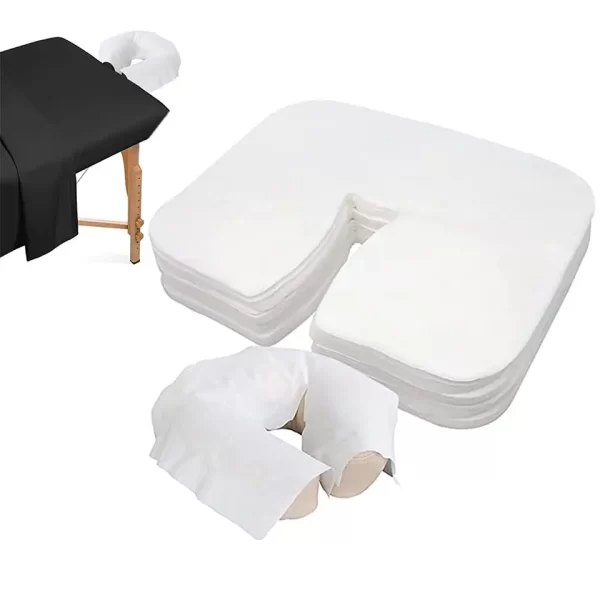Exploring Materiality and Green Solutions: A Comprehensive Guide to Disposable Face Cradle Covers
Introduction
From chiropractor clinics to spas, disposable face cradle covers have become an indispensable tool, promising hygiene, comfort, and convenience. As the frontline of defense against cross-contamination, these covers help maintain a sterile environment while offering customers a fresh, comfortable surface for each visit. Given their widespread use, it’s worth understanding the materials that go into these covers and how manufacturers are addressing sustainability in their production. This article delves into these crucial aspects, offering a comprehensive overview of the intricate world of disposable face cradle covers.
Understanding the Material Choices
Material selection is paramount for disposable face cradle covers, influencing not just user comfort and hygiene, but also their environmental impact. The ideal material should strike a balance between softness for comfort, durability to avoid tearing during use, and a barrier-like quality to prevent seepage of oils, sweat, or skin cells. Let’s explore some common materials:
- Non-Woven Fabrics:
Among the most used materials in disposable face cradle covers are non-woven fabrics. Renowned for their lightweight, soft texture, and affordability, they are perfect for single-use products. These fabrics are breathable, hypoallergenic, and create an effective barrier against potential contaminants.
- Polypropylene:
Polypropylene, a type of thermoplastic polymer, has gained favor due to its high durability and resistance to tears. This material is non-absorbent, preventing oils, sweat, or makeup from passing through the cover into the face cradle, ensuring maximum hygiene.
- Viscose:
Viscose, a semi-synthetic fabric, is used for its silk-like feel and moisture-absorbing capabilities. Slightly more expensive than other options, it adds a touch of luxury to the client’s experience, enhancing their comfort during their session.
- Blended Materials:
In many cases, manufacturers opt for blends of these materials to capitalize on the best properties of each. For example, a blend of viscose and polypropylene offers both comfort (viscose) and durability (polypropylene).
The Sustainability Question: Addressing the Environmental Impact
As disposable face cradle covers are single-use items, questions about their environmental impact are valid and increasingly pressing. Thankfully, many manufacturers have acknowledged these concerns and are making strides towards more environmentally-friendly solutions. Here’s how:
Biodegradable Materials:
As part of the move towards sustainable practices, manufacturers are turning to biodegradable materials for face cradle covers. These materials naturally decompose over time without leaving harmful residues, significantly reducing their environmental footprint.
Recycled Materials:
The use of recycled materials, including polypropylene and other plastics, is another step towards sustainability. This practice not only minimizes waste but also conserves resources, repurposing existing materials instead of creating new ones.
Sustainable Manufacturing Practices:
Beyond the materials themselves, a shift towards more sustainable manufacturing practices is underway. This includes measures like reducing energy consumption during production, minimizing waste, and employing recycled or recyclable materials for packaging.
The Sustainability Challenge: Balancing Hygiene and Environment
The challenge for manufacturers lies in striking the right balance between maintaining high standards of hygiene and reducing environmental impact. It’s a delicate equilibrium, ensuring that the push for sustainability doesn’t compromise the product’s core function—providing a sanitary, comfortable surface for each client.
An effective way to strike this balance is through education and awareness, both within the industry and among consumers. Businesses need to be transparent about their products’ environmental impact and the steps they’re taking to minimize it. On the other hand, consumers can demand more sustainable options, driving the market towards greener solutions.
Innovation on the Horizon: Future Trends
As we look to the future, the growing emphasis on sustainability is likely to spur innovation in the sector. New materials and manufacturing techniques could emerge, offering even more eco-friendly alternatives. For instance, there is potential for the development of compostable face cradle covers or covers made from sustainably sourced natural fibers. Technology also plays a role, with advancements like 3D printing offering the potential for reduced waste during production.
Conclusion: A Commitment to Sustainable Progress
Disposable face cradle covers, once a simple tool for hygiene and comfort, have now become a symbol of the wellness industry’s commitment to sustainable progress. As manufacturers continue to innovate, finding ways to balance the demand for cleanliness, comfort, and environmental responsibility, these humble covers reflect the industry’s evolution.
With growing consumer awareness and industry responsibility, the future of disposable face cradle covers is set to be greener and more sustainable. This shift towards sustainability demonstrates the adaptability of the industry and its commitment to caring for not just its clients but also the planet. As we continue on this journey, it’s clear that disposable face cradle covers will play a significant role in shaping a more sustainable wellness industry.
Please visit our website for more product details https://medposnonwoven.com/product/disposable-face-cradle-covers/

